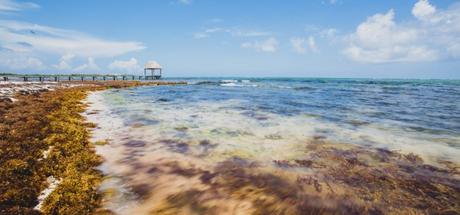
Turquoise waters and white sandy beaches, 90-degree days and tropical breezes. It's the stuff of vacation brochures and the dream of many a landlocked traveler with two weeks of downtime to spend in a luxurious location. So imagine my surprise when I stepped out on my balcony at a little beach town near Playa del Carmen, Mexico to...brown water, a sulfurous eggy smell and mounds of rotting beach seaweed higher than my head. This is not what I signed up for.
It's called sargassum, which is a type of seaweed, and it's the new normal in many locations in Florida, the Carribean and the Gulf of Mexico. Governments are coming up with ways to combat it with seaweed-gathering vessels and near-shore fences, but fighting a 5,500-mile swath (and growing) of this floating brown menace is a losing battle.
What's Creating the Sargassum Seaweed Problem?
In a word: us. The overgrowth of sargassum damaging the coastlines of the world's most picturesque beaches is a natural reaction to a manmade problem. It starts way over at the Amazon River, where the equivalent of 80 Olympic-sized swimming pools of water flows into the ocean every second .
That water isn't just water - it includes sediments, chemicals and runoff from the land in the Amazon. This runoff includes nitrates and other fertilizers from farming and cattle ranching.
You know who loves nitrates? Sargassum. It thrives on the stuff, eats it up and grows much faster than it would naturally. The sargassum bloom we're experiencing now is the worst it's been, and scientists say it's likely here to stay. Unfortunately, it's not just an eyesore (and a nose sore), but it also kills marine life and can be hazardous to your health if you breathe in the rotting stink on the beach for too long.
Don't Let Sargassum Ruin Your Trip
It's not all doom and gloom with sargassum, and it really didn't ruin my trip to Playa del Carmen. Here are three ways I worked around the seaweed.
- Track it: Sargassum is very beach-by-beach and day-by-day, which means it could be there one day and gone the next depending on the tides and the weather. I found a great sargassum Facebook group for Riviera Maya, where members posted daily pictures of what they're seeing from their beach. If one beach is bad, it's just a short walk or drive to another that may be better.
- Explore: If the sargassum gets you down, explore your destination for other things to do. We checked out Riviera Maya's freshwater cenotes and the Playa del Carmen aquarium on the really bad days. We also spent a lot of time beachcombing and observing the local wildlife. Hey, if a baby sea turtle hatching doesn't make you smile, sargassum may be the least of your problems.
- Embrace It: You can also embrace it. I found that if I swam about 30 feet from shore beyond the sargassum on bad days, the water became as crystal clear as I imagined in my mind's eye. I also spent about 10 minutes every morning raking sargassum off the beach with the hotel staff, which made the beach so much nicer for the rest of the day. "Putting your back into it" isn't for everyone, but I also made some new friends in the process.

